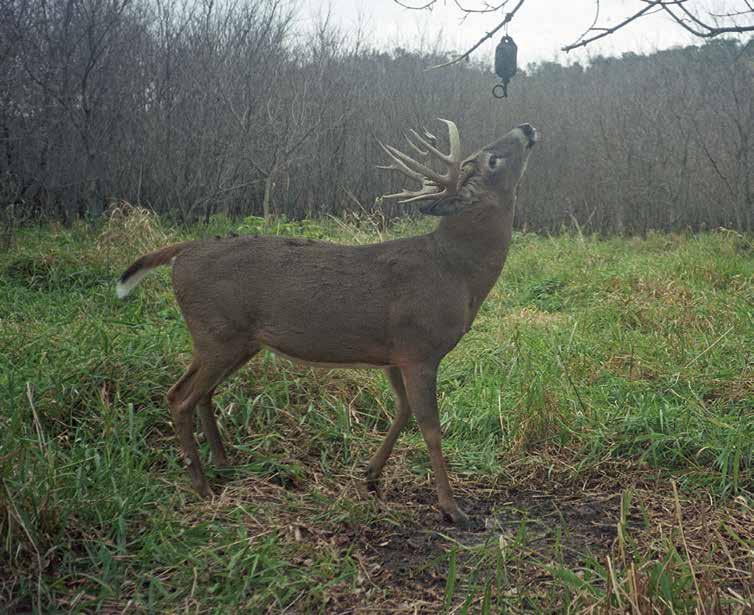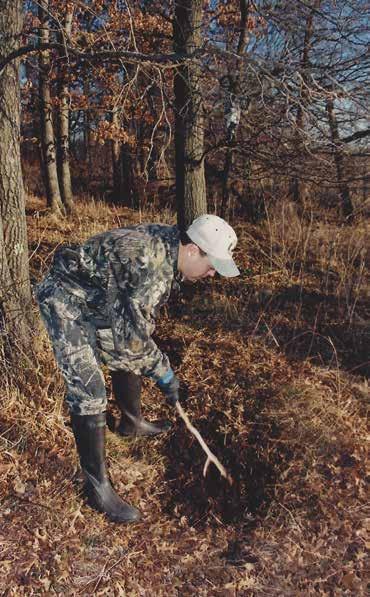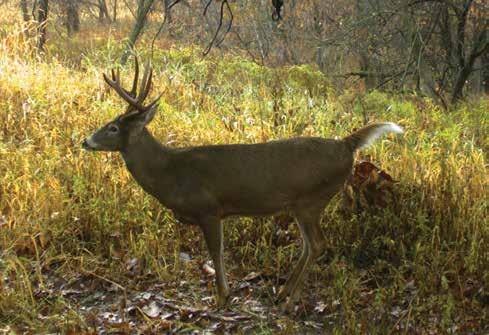
5 minute read
Use Mock Scrapes to Attract Bucks
By: Todd Amenrud
After a buck makes a scrape, it can be worked over by many different bucks. One morning while hunting along the Red River in Manitoba, I witnessed 12 bucks work over the same scrape before 10 a.m. The other bucks are saying, “This is my territory, too.” Mother Nature gives them a way to sort out their pecking order. Through months of sparring and posturing, by the time breeding gets underway, they have a loose hierarchy worked out. This helps to limit serious, life-threatening fights.
Advertisement
A buck’s scrape is a multistimuli sign post made by a buck to convey a variety of messages to the other deer in the area. Some call a “buck’s scrape” a “calling card to the does.” I disagree; I feel a scrape’s primary function is to be a buck’s “breeding-territory marker” to ALL deer in the area, especially the other bucks.
When actual breeding gets underway, little attention is focused on scrapes. However, as an aid for hunters to learn about a buck and a contrivance to draw a buck close for a shot, scrapes are at the top of the list. During parts of the fall, they can be magnets for buck activity.
While bucks can make scrapes without a “licking branch” present, one is usually necessary to trigger the act. It doesn’t happen often, 99.9% of the time an overhanging branch about 5 to 6 feet off the ground, most often referred to as a “licking branch,” is necessary to induce scrape activity.
Interrelating with the licking branch by chewing on and/or licking the branch, and scent marking it with their forehead and preorbital glands are almost always the first steps in the process when a buck makes a scrape. The majority of scrapes are made underneath these licking branches which are usually about 5.5 feet off the ground.

The actual mock ground scrape is best created with a sturdy stick found in the area. Try to make the scrape on flat ground (if possible) and make sure it is free from all debris. (Photo Credit: Todd Amenrud)
The actual ground scrape is made by the buck pawing the ground and whisking the leaves and dirt away. Then, the majority of the time he will urinate down his hocks and over his tarsal glands into it. The order of these steps may vary from one buck to another, but most often they will occur in exactly this order.
“Mock” scrapes are a great way to entice bucks into an area, hold them there longer and bring them close enough for a shot. The best results I’ve had come from making a “series of mock scrapes” and using Magnum Scrape Drippers over them – my own “fake scrape line,” so to say. Magnum Scrape Drippers are heat-activated so they drip during daylight hours conditioning bucks to show up during legal shooting light and staying in the area longer.
The new Super Charged Scrape Dripper is also a tool I use at certain times. It has a higher output than the Magnum Dripper, to replicate more deer traffic. The new Super Charged Dripper will operate for about seven to 12 days on 4 ounces of scent, where a regular Magnum Dripper will put out that same 4 ounces in about two to three weeks. Both have their place, in my view.
So where should you locate your mock scrapes? You can’t just go out to any overhanging branch and expect success. Concentrate on areas closer to bedding areas. You want to target an area a buck is already claiming as his – move in and make it look and smell like there’s a rival buck invading his turf. Look for areas with the largest scrapes, spots that contain numerous scrapes or clusters of scrapes, and scrapes that you know have been freshened again and again. Once you locate an area with activity, try to duplicate the variables the local bucks preferred.

Here you see a buck urinating down his tarsal glands into a mock scrape previously created (notice the Magnum Dripper hanging above). This is usually the last step in the process when a buck makes his own scrape. (Photo Credit: Paul Marion)
You can also use a buck’s existing scrape(s). As mentioned, in the whitetails’ world the same scrape may be utilized by many different bucks. However, more often than not, I’ll make my own, trying to copy the specifics found with existing scrapes in the area.
The actual mock scrape is best created with a sturdy stick found in the area. Try to make the scrape on flat ground (if possible) and make sure it is free from all debris.
I prefer to use several drippers, each on their own scrape, and possibly vary the scent in each. I believe with more than one mock scrape you’re increasing the chances that something’s going to be right with at least one of them that will draw a response. I’ve used as many as six drippers and created over a dozen mock scrapes in an area about the size of an acre. My three favorite scents are Active Scrape, Golden Scrape or Trail’s End #307 used in the dripper.
Consistent with just about every successful mock scrape setup I’ve had are “mock rubs” that I also produce. With a pruner or wood rasp, I “rake-up” two- to six-inch saplings in the area. A real intruder buck would typically also mark the territory in this way. On the rubs, and in various other places around the setup, I use a scent called Mega-Tarsal Plus. It’s a territorial intrusion scent. The illusion I want to create is that a foreign buck has moved in on his breeding territory. Select Buck Urine is also placed out at several key places in the area.
Timing is important for mock scrapes to work. It can vary from late September in the northern tier of states, into December in the South. I seem to have my best luck from the second week of October through the first week of November and then again after Thanksgiving and throughout the rest of the season. When the bucks are actively chasing and breeding, mock scrapes are probably not your best tactic. You want the bucks to be “claiming and protecting territory.”

Almost always, the first step in creating a scrape is a buck licking and/or chewing on an overhanging branch and scent marking it with his forehead and preorbital glands. This is obviously why it’s referred to as a “licking branch.” (Photo Credit: Todd Amenrud)
When making a mock scrape you must be cautious of scent-transfer. Rubber gloves should be worn to avoid leaving smells behind. I actually like to hang my drippers on a higher branch above the licking branch if available. This keeps bucks from getting a good whiff of any foreign odors that may have permeated the dripper’s cloth cover.
Don’t expect your exact mock scrape(s) to get hit. Sometimes they may annihilate the actual mock scrape, but my goal is simply to draw them to the area during legal shooting light and hold them there for a longer period of time. I could care less if they touch my mock scrapes; I just want the shot opportunity.
A hunter should use all other information in conjunction with your mock scrapes. Know where the does are bedding, what the preferred food sources are, where your target buck is bedding and where he may have other scrape areas. Consider it all collectively before making your setup.

